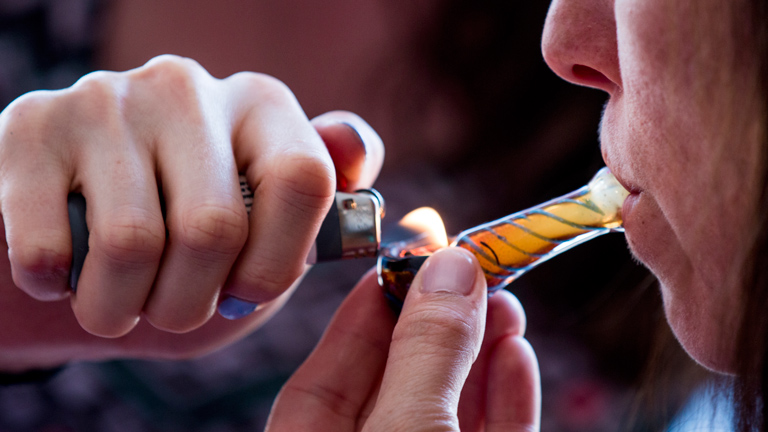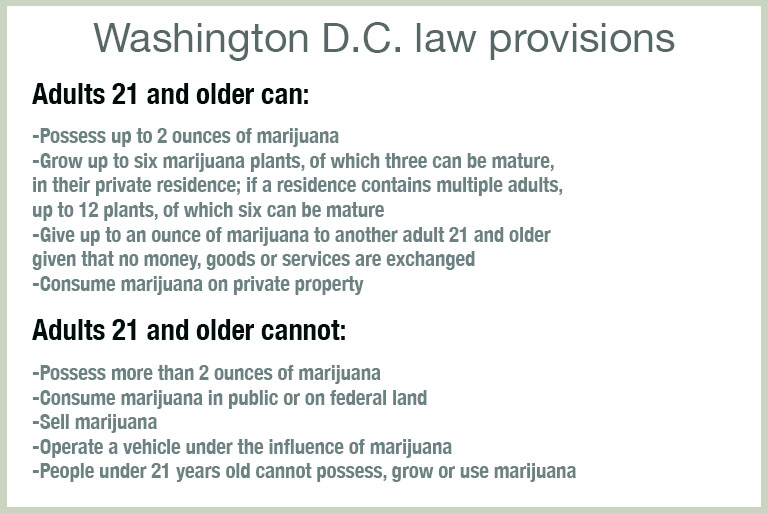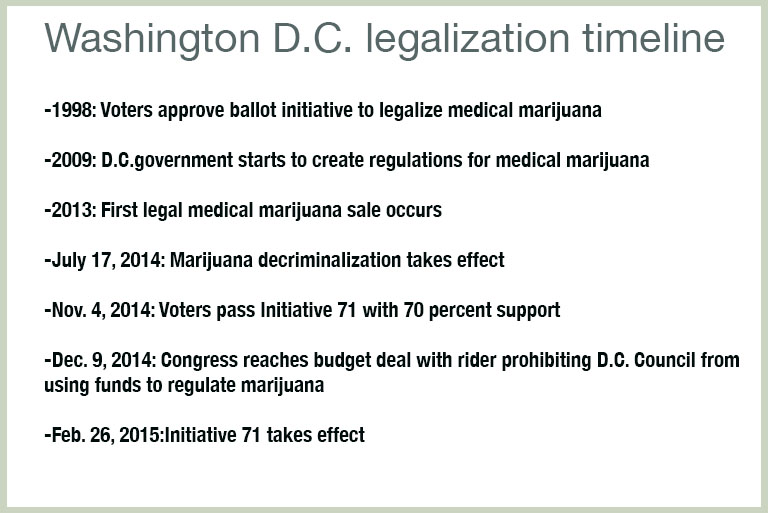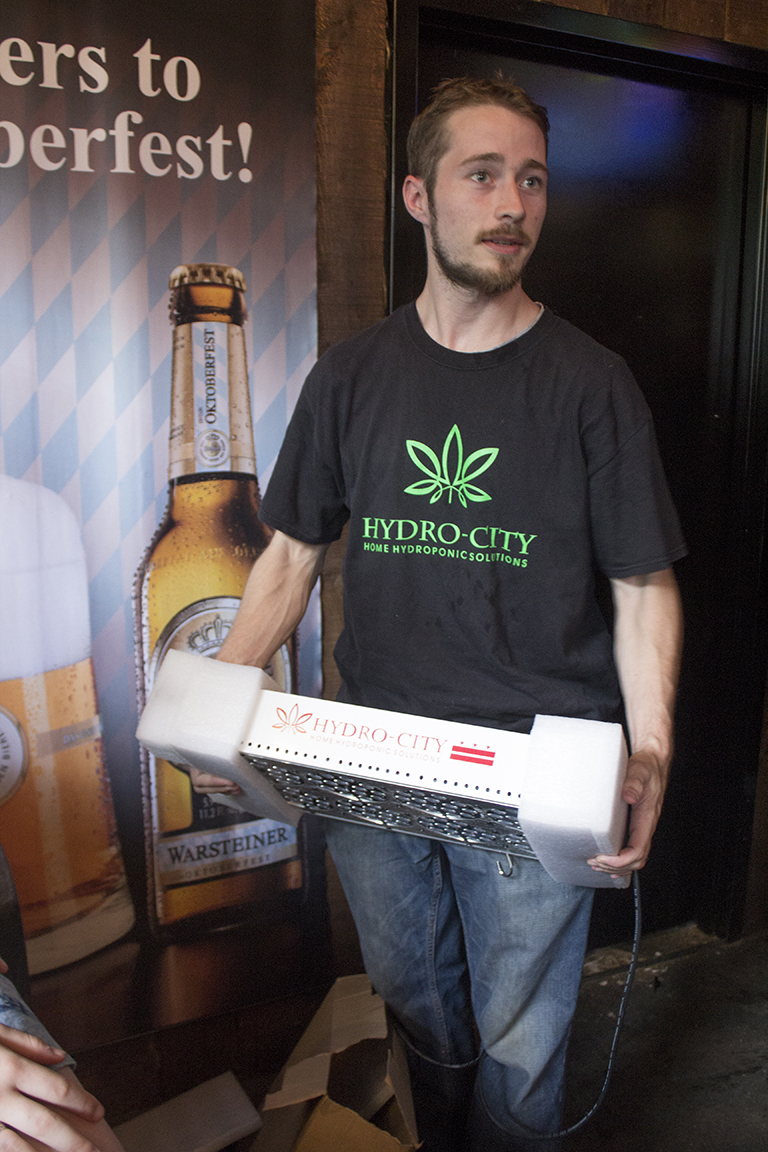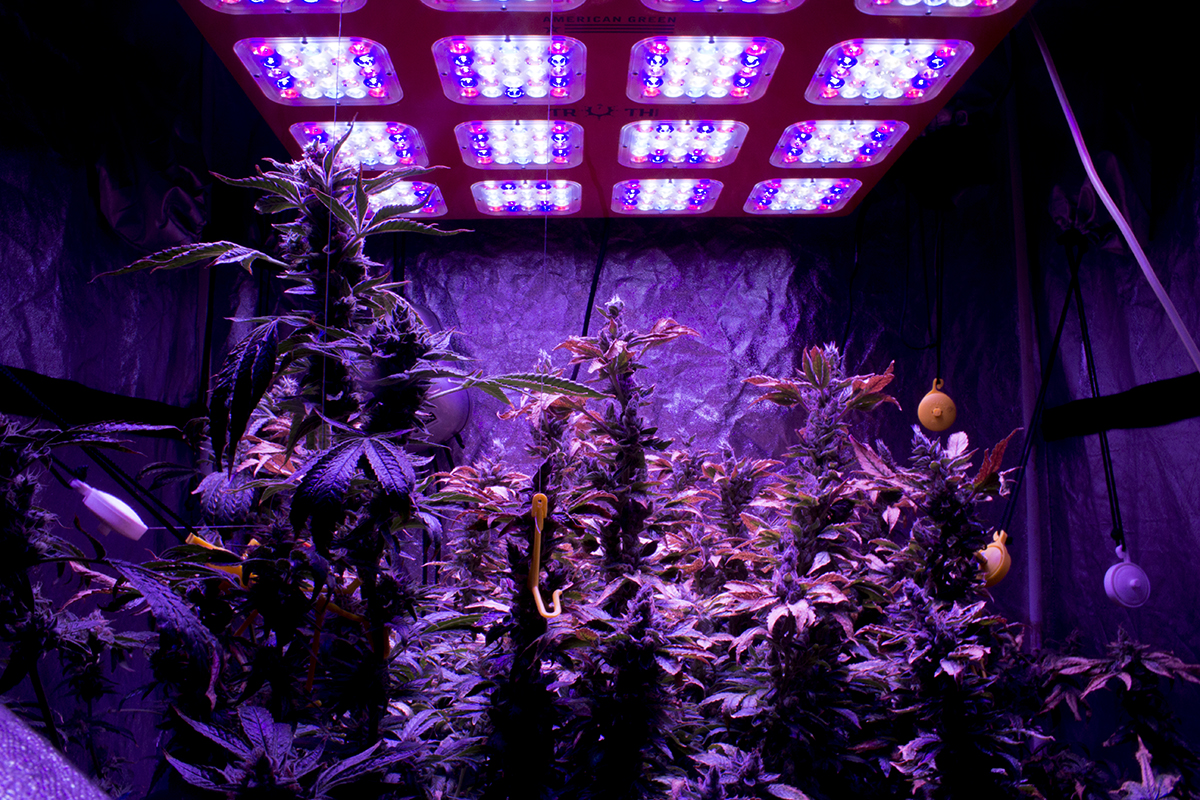After decriminalization went into effect in July 2014, local activists landed a measure on the November ballot to eliminate all penalties for possession of up to 2 ounces, and allow D.C. residents to grow up to six plants in their homes.
Buying and selling the drug would remain illegal, at least in the short term, but home cultivation would give users access to pot. A friend or acquaintance could also give them up to an ounce – as long as no money, goods or services were exchanged for it. If the city wanted to set up a system for taxing and regulating sales, the D.C. Council would have to initiate that process.
In November, about 70 percent of District voters approved this partial legalization ballot measure, called Initiative 71. It passed in every precinct except one, according to the D.C. Board of Elections.
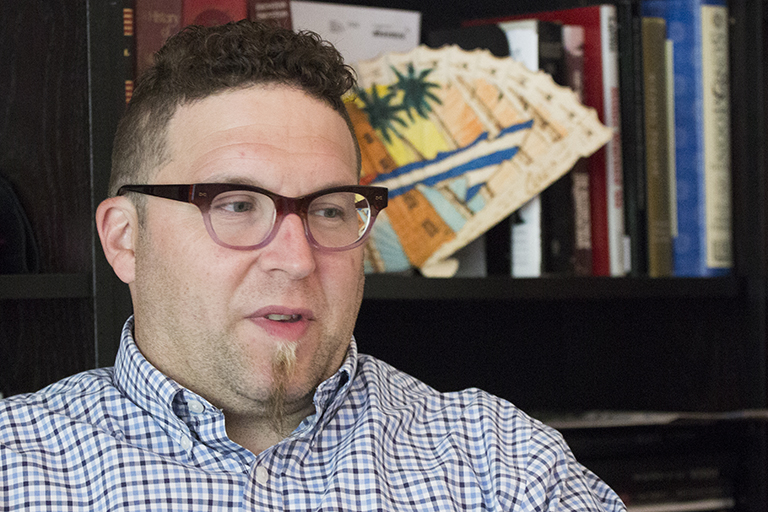
PLAY Adam Eidinger, chairman of the D.C. Cannabis Campaign, speaks about racial disparities in marijuana arrests, which Initiative 71 was designed to help combat. (Photo by Karen Mawdsley | News21)
While campaigning for Initiative 71 last year, activists claimed the measure was meant to benefit those most likely to face arrest: members of black, lower income communities. D.C. Cannabis Campaign posters read, “Legalization ends discrimination.”
Stroup said that when NORML had approached black leaders in D.C. in the 1970s, they opposed legalization.
“They would essentially say, ‘Look, we’re sympathetic, but we can’t support it because drugs have ravaged our communities. We just can’t take a position that says more drugs,’” Stroup said. “On the other hand, we also knew they were the people who were paying the heaviest price of prohibition.”
The proposed law was supposed to make a difference for black residents, but as recently as five years ago, a majority of blacks in D.C. opposed legalization, according to a Washington Post poll.
Opinion appeared to shift in 2014, with 58 percent of blacks supporting legalization, according to a Post poll. Paul Zukerberg, a longtime marijuana activist and D.C.-based lawyer, said the change in opinion was driven by the conversation about black arrests.
“Once the racial disparity issue was discussed and people began to understand that – which certainly the centerpiece of that was the ACLU report – once people could see those numbers, the entire city came around so that even a majority in the Wards 6, 7 and 8 voted for Initiative 71,” Zukerberg said, referring to predominantly black parts of the city.
Police and public safety
That dialogue also prompted a discussion about law enforcement practices in the District. After the ACLU released its report, Metropolitan Police Department Chief Cathy Lanier publicly denied that D.C. officers targeted black residents.
Lanier told a local news station earlier this year that officers “for the last 20 years have avoided possession-of-marijuana arrests,” which are rarely prosecuted. “It was a waste of time for officers to make possession-of-marijuana arrests,” she said.
Since possession was legalized, D.C. Council member David Grosso said the chief has told him that the police are “taking a pretty hands-off approach” to enforcement. “The ACLU is watching this very closely to make sure there’s a reduction in arrests,” he said.
Between Feb. 26, when pot was legalized, and July 22, D.C. police made 120 marijuana-related arrests, according to data provided by MPD’s public information office. Of those arrests, 43 were for consumption of marijuana.
Fifty-seven arrests were for possession of marijuana with intent to distribute. More than half of those arrests took place in the police department's sixth district.
In 2010, law enforcement agencies including MPD made 5,393 marijuana arrests in D.C., according to an analysis by the ACLU of the Nation’s Capital. More than 1,000 of those arrests occurred in 6D, a community east of the Anacostia River with many of the city’s public housing projects.
Drug use and sales tend to be more out in the open in low-income, minority communities, which increases the chances of encounters with police, according to a Human Rights Watch report released in 2009. Meanwhile in wealthier areas, illegal activity is likely to occur behind closed doors.
“The rich and privileged had the benefit all along, and what we’re doing is we’re extending the benefit,” Zukerberg said. “In other words, for wealthy and privileged people, it’s always been decriminalized because there’s been no enforcement. There’s no stop-and-frisk up in Tenleytown,” a majority-white, higher-income neighborhood.
Grosso introduced a bill to tax and regulate pot sales, but Republicans in Congress have blocked the legislation from moving forward. That interference has driven together pot activists and advocates for D.C. statehood in mutual frustration. Many of the same faces appear at both D.C. NORML meetings and demonstrations for the District to have total control over its budget process and a voting representative in Congress.
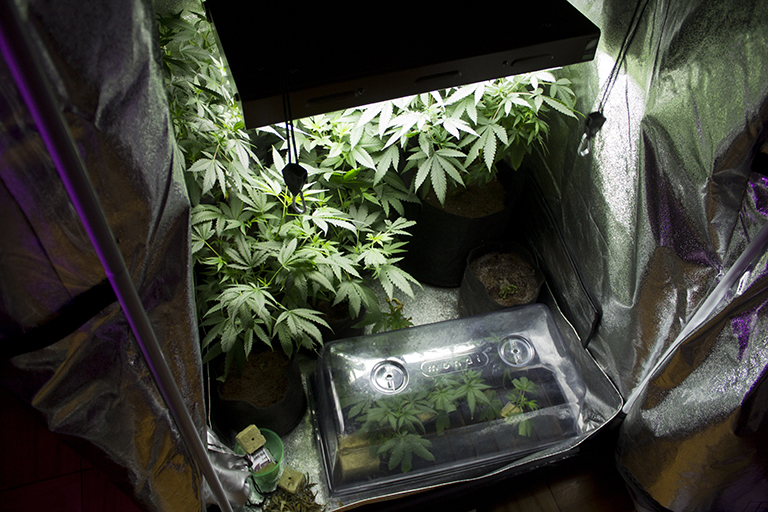
Washington, D.C. residents can grow up to six marijuana plants in their homes, three of which can be mature. (Photo by Karen Mawdsley | News21)
The Senate Appropriations Committee recently approved a spending bill that would allow D.C. to tax and regulate pot sales. The budget plan that President Barack Obama proposed in February would also allow it. But a spending bill in the House would maintain the status quo, keeping sales illegal.
A legal market in D.C. could be worth $130 million a year, city officials have estimated.
Grosso said marijuana investors have lobbied the Council, but “they know we’re not the problem.”
“If Congress would get off our backs, we would have a law passed in a couple of weeks,” Grosso said. “The business community knows they would be preaching to the choir if they came to talk to us.”
Those who fear the marijuana industry will become the next “Big Tobacco" have praised the D.C. law for preventing large-scale commercialization. But Grosso said he is more concerned about public safety. The District native said he grew up in a neighborhood where drug use was common, and he watched people buy drugs on street corners and out of car windows.
“That sends a whole sense of uneasiness into the community and makes it harder for people to move forward in life in a positive way,” Grosso said. “I think the idea that we’re in some great space in D.C. is misguided.”
A growing medical marijuana program
Recreational legalization has had ripple effects in the medical marijuana realm. Corey Barnette, the owner of a medical marijuana cultivation center in D.C. called District Growers, said he has seen an increase in demand at the dispensary level, which has translated into an increase in demand for the marijuana that his business grows.
“What’s happened is that we do see a lot of people, who we would call closet medicators, are more open to marijuana programs,” Barnette said. “We can debate whether or not that was a direct result of Initiative 71, but I can tell there has been a spike in the level of interest and level awareness of the medical marijuana program.”
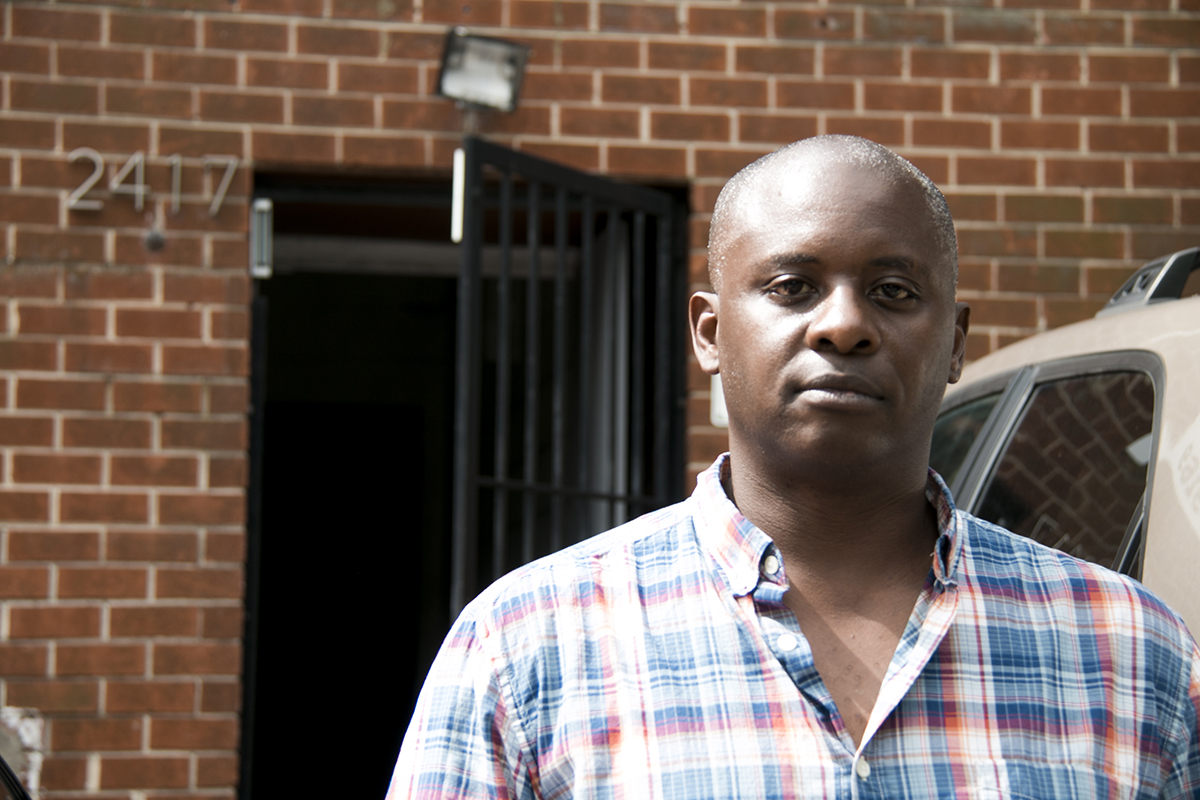
Owner Corey Barnette stands outside District Growers cultivation center in northeast D.C. He also owns Metropolitan Wellness Center, a dispensary, and said he's seen an increase in demand for medical marijuana. (Photo by Karen Mawdsley | News21)
In July 2014, only 738 patients were registered with the Department of Health. By July 27 of this year, there were 3,948.
Barnette pointed out that the medical marijuana program had begun to explode before recreational legalization. The D.C. Council loosened the rules for obtaining medical marijuana last summer, setting off a surge in enrollment.
The District has seven cultivation centers and five dispensaries, according to the health department, and the D.C. Council has increased the number of plants that cultivators can grow from 95 to 500 to 1,000. But Barnette said even that hasn’t been enough to meet demand. It has driven people to the black market, where marijuana is untested and sellers can’t be held accountable.
And Barnette said he’s not worried about home-grown plants competing with his product.
“Right now, all over D.C., people are learning just how difficult it is – or just how much attention is necessary – to grow a plant to pharmaceutical grade,” he said. “You can grow your own tomatoes. Most people don’t. You can grow your own carrots. Most people don’t. You can make your own beer. Most people don’t.”
